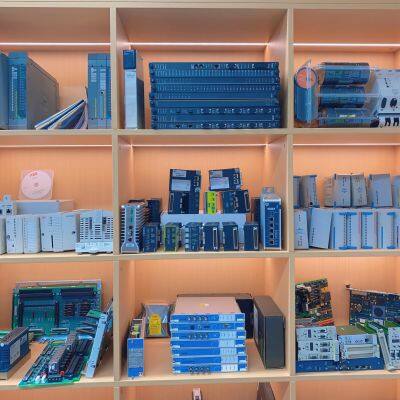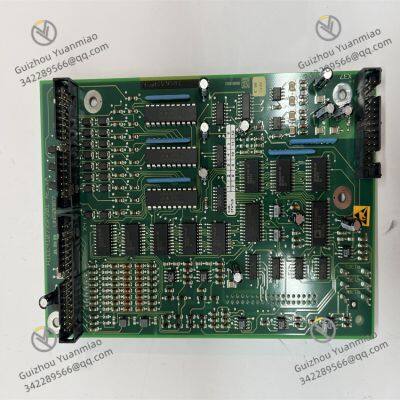Product Description
I. Overview
ABB HIEE305114R00R0001 is a multivariable high-performance process control module under the Industrial IT series of the Swiss ABB Group. Its core positioning is to provide high-precision collaborative control and intelligent interlocking solutions for complex multi-parameter coupled industrial processes (such as multi-stage reactions, multi-stream regulation, and precision batch control) in industries including chemical engineering, oil and gas, energy, and pharmaceuticals. It serves as a core control unit for ABB AC 800M or Freelance 800F series DCS (Distributed Control Systems).
Integrating high-density signal channels, advanced multivariable control algorithms, and flexible expansion interfaces, the module enables synchronous collection, collaborative calculation, and precise output of multiple types of process parameters (e.g., temperature, pressure, flow rate, liquid level, and composition). It effectively addresses control pain points in complex working conditions, such as mutual interference between multivariables, large lag responses, and difficulty in adapting to dynamic operating conditions. It is suitable for scenarios like multi-reactor series control in large petrochemical integrated plants, multi-unit collaborative regulation in power plants, and multi-step batch production in the pharmaceutical industry, ensuring the stability, safety, and efficiency of industrial production processes.
The module adopts a standard 3U industrial board design (dimensions approximately 230mm×170mm×42mm), compatible with ABB standard cabinet slots. It achieves low-latency data interaction with the system main controller via a high-speed backplane bus (transmission rate: 100MB/s). The housing is made of enhanced flame-retardant plastic (UL94 V-0 grade) with a built-in heat dissipation duct, increasing heat dissipation efficiency by 20% to adapt to high-load operation scenarios. It operates within a temperature range of -15℃~65℃ and a relative humidity of 5%~95% (non-condensing), capable of withstanding complex environments such as high humidity in chemical workshops and high temperatures in the energy industry.
It supports full redundancy configuration (power redundancy, communication redundancy, I/O channel redundancy) with a Mean Time Between Failures (MTBF) of ≥180,000 hours, meeting the strict requirements of industrial processes for "continuous production and low failure rate". Additionally, it is compatible with third-party standard signal equipment and supports modular expansion, allowing flexible addition or removal of I/O modules according to process needs to adapt to control scenarios of different scales.

II. Technical Parameters
Electrical Parameters
2. Environmental and Reliability Parameters
3. Control and Communication Parameters

III. Functional Features
1. High-Density and Multi-Type Signal Processing
Based on high-density signal channels, HIEE305114R00R0001 covers all types of signal requirements in industrial processes and supports synchronous multi-parameter collection and collaborative control:
High-Precision Analog Signal Processing
It integrates 16 analog input (AI) channels and 8 analog output (AO) channels. The AI channels support signals such as 4-20mA DC, 0-5V DC, PT100/RTD (-200℃~850℃), and thermocouples (Type K/J/E/T), using a 24-bit high-precision A/D converter with a sampling accuracy of ±0.02% FS and a sampling period ≤50μs. For example, in the control of multi-stage chemical reactors, it can synchronously collect signals including temperatures of 6 reaction stages (Type K thermocouples), pressures at 4 feed inlets (4-20mA), flow rates at 3 discharge outlets (4-20mA), and liquid levels at 3 points (0-5V), with a measurement error ≤0.05%, providing accurate data support for multivariable collaborative control.
The AO channels support 4-20mA DC or 0-10V DC output, with 16-bit D/A resolution and output accuracy of ±0.05% FS. They can drive high-precision control valves, servo frequency converters, and other actuators. For instance, based on temperature deviations across multiple reaction stages, it collaboratively outputs regulation signals to control the opening of steam valves in each stage, achieving synchronous and stable reaction temperature control.
Efficient Digital and Pulse Signal Interaction
It includes 32 digital input (DI) channels and 16 digital output (DO) channels. The DI channels support 24V DC dry/wet contact signals with a response time ≤500ns, enabling collection of high-frequency status signals from on-site equipment (e.g., fast valve switching feedback, high-frequency fault contacts of pump sets, safety interlock trigger signals). In multi-station oil pipeline control, for example, it real-time collects "overpressure alarm" signals from 16 pressure switches, "flow interruption" signals from 8 flow switches, and "valve open/close in place" signals from 8 valves, ensuring millisecond-level status response.
The DO channels use solid-state relay outputs (3A@250V AC/30V DC), support software-configurable normally open/normally closed modes, and have overcurrent and overvoltage protection. They can drive high-frequency solenoid valves, quick shut-off valves, alarm devices, etc. For example, after receiving an "emergency stop" command, it cuts off the power supply of 12 feed valves and 4 heating devices via the DO channels within 100ms.
Additionally, the module is equipped with 4 high-speed pulse input (PI) channels that support 0-50kHz pulse signals. It can connect to high-precision encoders, turbine flowmeters, and other devices to realize functions such as high-speed flow accumulation (accuracy ±0.1%) and equipment speed measurement (resolution ±1rpm).
Signal Anti-Interference and Isolation Protection
All signal channels adopt optoelectronic isolation (isolation voltage ≥3kVrms) and three-stage EMC filtering (common-mode filtering, differential-mode filtering, RF filtering) design, complying with the IEC 61000-6-2 industrial anti-interference standard. They provide ESD protection of ±10kV (air discharge)/±6kV (contact discharge), EFT protection of ±4kV, and surge protection of ±6kV at the power port. For example, in the collaborative control of multiple rolling mills in a steel plant, it can resist high-frequency electromagnetic interference generated by frequency converters and high-voltage motors, ensuring analog signal fluctuation ≤0.02% FS and no false triggering of digital signals, thus guaranteeing control accuracy and reliability.
2. Advanced Multivariable Control Algorithms
The module has built-in rich industrial-grade multivariable control algorithms to meet the collaborative control needs of complex processes and achieve precise multi-parameter regulation:
Multivariable Model Predictive Control (MPC)
It supports dynamic model-based multivariable predictive control, capable of processing 8 controlled variables (CVs) and 10 manipulated variables (MVs) simultaneously. By predicting the variation trend of process parameters in the future time period, it optimizes control strategies in advance to offset coupling interference between multivariables. For example, in a catalytic cracking unit of an oil refinery, with "reaction temperature, regeneration temperature, and product yield" as CVs and "feed rate, reflux ratio, and main air flow" as MVs, the module uses the MPC algorithm to real-time optimize the output of each MV. Even when the feed composition fluctuates by ±5%, the reaction temperature can still be controlled within ±0.5℃, and the product yield fluctuation is ≤1%, far exceeding the performance of traditional PID control.
Adaptive PID and Cascade-Feedforward Control
It integrates an adaptive PID algorithm that can real-time adjust PID parameters (proportional gain Kp, integral time Ti, derivative time Td) based on the dynamic characteristics of the process object (e.g., time lag, gain change) without manual intervention. For example, in boiler water level control in power plants, when the feedwater pressure fluctuates by ±10%, the algorithm automatically optimizes PID parameters to maintain the water level control accuracy within ±3mm (range 0-6m).
It also supports the combination of cascade control (up to 3 levels) and feedforward control. In the control of a chemical distillation column, for instance, "top column temperature" is used as the primary control variable, "reflux flow rate" as the secondary control variable, and a "feed flow rate" feedforward signal is introduced to pre-compensate for the impact of feed fluctuations on column temperature. This ensures the column temperature control deviation is ≤0.2℃, avoiding lag and overshoot issues in traditional control.
Batch Control and Sequential Logic
Compliant with the ISA-88 batch control standard, it supports recipe management, phase control, and sequential logic programming. It integrates an IEC 61131-3 standard programming environment (supporting LD/FBD/ST/IL/FC) to realize automated control of complex batch production processes. For example, in the production of sterile injections in the pharmaceutical industry, ST programming is used to achieve sequential control of the entire process ("raw material preparation→sterilization→filling→sealing→inspection"). It also supports the storage of 100 sets of recipes; switching product specifications only requires calling the corresponding recipe without re-programming. The logical operation response time is ≤500μs, meeting high-speed interlock requirements (e.g., triggering pressure relief valves and alarm devices within 50ms when the pressure of a biological fermentation tank exceeds the limit).


GE IS200AEADH1AAA Input/Output Grid Fork Board
Basler Electric DECS125-15-B1 Digital Excitation Controller
BENTLY NEVADA 3701/55 ADAPT Condition Monitor
GE L90-W03-HKH-F8L-H6P-L6C-N6C-S6C-U6L-W7G Multilin L90 protector
ABB PM863K01 3BSE088381R1 AC 800M processor unit Controller
ABB NGC8206 Natural Gas Chromatographs
Lam Research 810-068158-014 PCBA CIRCUIT BOARD
GE DS200TCDAH1BJE Mark V Digital I/O Board
ABB 086329-004 End Column Sensor Module
ABB 086370-001 Circuit Board
ABB 086339-501 Digital Input Module
ABB 086348-001 PC Board
 yezi
Hi there! Welcome to my shop. Let me know if you have any questions.
yezi
Hi there! Welcome to my shop. Let me know if you have any questions.




